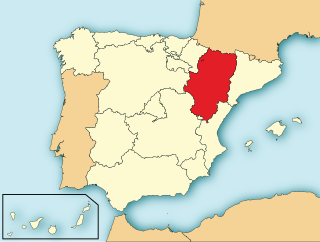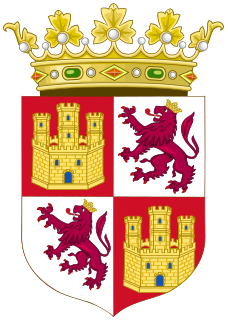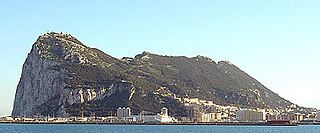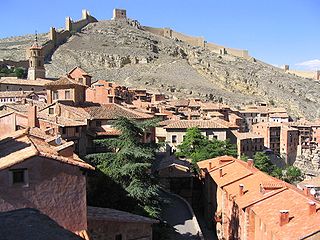Related Research Articles

Rodrigo Díaz de Vivar was a Castilian knight and warlord in medieval Spain. The Moors called him El Cid, which meant the Lord, and the Christians, El Campeador, which means "the Champion" in modern Spanish, but is literally translated as "the Master of the Battlefield" in Old Spanish. He was born in Vivar del Cid, a village near the city of Burgos. Díaz de Vivar became well known for his service in the armies of both Christian and Muslim rulers, his exile, and his temporary conquest of Valencia, which became independent for a brief period in the Reconquista. After his death, El Cid became Spain's celebrated national hero and the protagonist of the most significant medieval Spanish epic poem, El Cantar de Mio Cid.

Alfonso II, called the Chaste or the Troubadour, was the King of Aragon and, as Alfons I, the Count of Barcelona from 1164 until his death. The eldest son of Count Ramon Berenguer IV of Barcelona and Queen Petronilla of Aragon, he was the first King of Aragon who was also Count of Barcelona. He was also Count of Provence, which he conquered from Douce II, from 1166 until 1173, when he ceded it to his brother, Ramon Berenguer III. His reign has been characterised by nationalistic and nostalgic Catalan historians, as l'engrandiment occitànic or "the Pyrenean unity": a great scheme to unite various lands on both sides of the Pyrenees under the rule of the House of Barcelona.

Ferdinand IV of Castile called the Summoned, was the king of Castile and León from 1295 until his death.

Petronilla, whose name is also spelled Petronila or Petronella, was the queen of Aragon from the abdication of her father, Ramiro II, in 1137 until her own abdication in 1164. She was the last ruling member of the Jiménez dynasty in Aragon, and by marriage brought the throne to the House of Barcelona.

The Kingdom of Aragon was a medieval and early modern kingdom on the Iberian Peninsula, corresponding to the modern-day autonomous community of Aragon, in Spain. It should not be confused with the larger Crown of Aragon, that also included other territories — the Principality of Catalonia, the Kingdom of Valencia, the Kingdom of Majorca, and other possessions that are now part of France, Italy, and Greece — that were also under the rule of the King of Aragon, but were administered separately from the Kingdom of Aragon.

The Crown of Aragon was a composite monarchy, also nowadays referred to as a confederation of individual polities or kingdoms ruled by one king, with a personal and dynastic union of the Kingdom of Aragon and the County of Barcelona. At the height of its power in the 14th and 15th centuries, the Crown of Aragon was a thalassocracy controlling a large portion of present-day eastern Spain, parts of what is now southern France, and a Mediterranean "empire" which included the Balearic Islands, Sicily, Corsica, Sardinia, Malta, Southern Italy and parts of Greece. The component realms of the Crown were not united politically except at the level of the king, who ruled over each autonomous polity according to its own laws, raising funds under each tax structure, dealing separately with each Corts or Cortes. Put in contemporary terms, it has sometimes been considered that the different lands of the Crown of Aragon functioned more as a confederation than as a single kingdom. In this sense, the larger Crown of Aragon must not be confused with one of its constituent parts, the Kingdom of Aragon, from which it takes its name.
In many ways, the history of Spain is marked by waves of conquerors who brought their distinct cultures to the peninsula. After the passage of the Vandals and Alans down the Mediterranean coast of Hispania from 408, the history of medieval Spain begins with the Iberian kingdom of the Arianist Visigoths (507–711), who were converted to Catholicism with their king Reccared in 587. Visigothic culture in Spain can be seen as a phenomenon of Late Antiquity as much as part of the Age of Migrations.

The 1412 Compromise of Caspe was an act and resolution of parliamentary representatives of the constituent realms of the Crown of Aragon, meeting in Caspe, to resolve the interregnum following the death of King Martin of Aragon in 1410 without a legitimate heir.

The gittern was a relatively small gut strung round-backed instrument that first appears in literature and pictorial representation during the 13th century in Western Europe. It is usually depicted played with a quill plectrum, as we can see clearly beginning in manuscript illuminations from the thirteenth century. It was also called the guiterna in Spain, guiterne or guiterre in France, the chitarra in Italy and quintern in Germany. A popular instrument with court musicians, minstrels, and amateurs, the gittern is considered an ancestor of the modern guitar and other instruments like the mandore, bandurria and gallichon.

The House of Trastámara was a dynasty of kings in Spain, which first governed in Castile beginning in 1369 before expanding its rule into Aragon, Navarre and Naples. They were an illegitimate cadet line of the House of Ivrea.

The Crown of Castile was a medieval polity in the Iberian Peninsula that formed in 1230 as a result of the third and definitive union of the crowns and, some decades later, the parliaments of the kingdoms of Castile and León upon the accession of the then Castilian king, Ferdinand III, to the vacant Leonese throne. It continued to exist as a separate entity after the personal union in 1469 of the crowns of Castile and Aragon with the marriage of the Catholic Monarchs up to the promulgation of the Nueva Planta decrees by Philip V in 1715.
Duke of Gandía is a title of Spanish nobility that was first created in 1399 by Martin of Aragon and granted to Alfonso of Aragon and Foix. It has its origin in the lordship of Gandía created in 1323 by James II of Aragon. Later, having no direct descendants, the title passed from the House of Aragon to the House of Trastámara.

Ferdinand II was King of Aragon from 1479 and, by marriage, King of Castile from 1474, reigning over a dynastically unified Spain jointly with his wife Isabella I. Ferdinand is considered de facto the first King of Spain, being described as such during his own lifetime, although Castile and Aragon remained de jure two different kingdoms until the Nueva Planta Decrees of 1716.
The Spanish monarchs of the House of Habsburg and Philip V used separate versions of their royal arms as sovereigns of the Kingdom of Naples-Sicily, Sardinia and the Duchy of Milan with the arms of these territories.

The First Siege of Gibraltar was a battle of the Spanish Reconquista that took place in 1309. The battle pitted the forces of the Crown of Castile under the command of Juan Núñez II de Lara and Alonso Pérez de Guzmán, against the forces of the Emirate of Granada who were under the command of Sultan Muhammed III and his brother, Abu'l-Juyush Nasr.

Juan Núñez I de Lara y León, also known as "el Gordo" or "the Fat", was a Spanish noble. He was the head of the House of Lara, Lord of Lerma, Amaya, Dueñas, Palenzuela, Tordehumos, Torrelobatón, and la Mota. He was further known as Señor de Albarracín through his first marriage with Teresa Álvarez de Azagra.

The Siege of Albarracín was a battle fought during the reign of Peter III of Aragon, King of Aragón from the months of April to September 1284. Albarracín, which had for some time belonged to Juan Núñez I de Lara, the head of the House of Lara, was besieged by an Aragonese force. The siege resulted in the successful taking of the city by Aragonese forces after which, Peter III handed gifted the city to his illegitimate son, Ferdinand of Aragón.
The Lordship of Albarracín was an independent Christian lordship in the Kingdom of Aragón located in and around the city of Albarracín. Its location was a buffer wedged between the Kingdom of Aragón and the Kingdom of Castile. The Señorío was created after the partition of the Taifa of Albarracín belonging to the Berber line of Banu Razín.
Rodericus was a French composer of the 14th century.
References
- ↑ "Rodrigo de la Guitarra". The New Grove Dictionary of Music and Musicians . 2nd edition, Oxford, 2001.
- ↑ M.C. Gómez, "Some Precursors of the Spanish Lute School". Early Music 20 (1992), pp. 583-593.
- ↑ Gilbert Reaney, "The Manuscript Chantilly, Musee Conde 1047". Musica Disciplina 8 (1954), pp. 78-79.